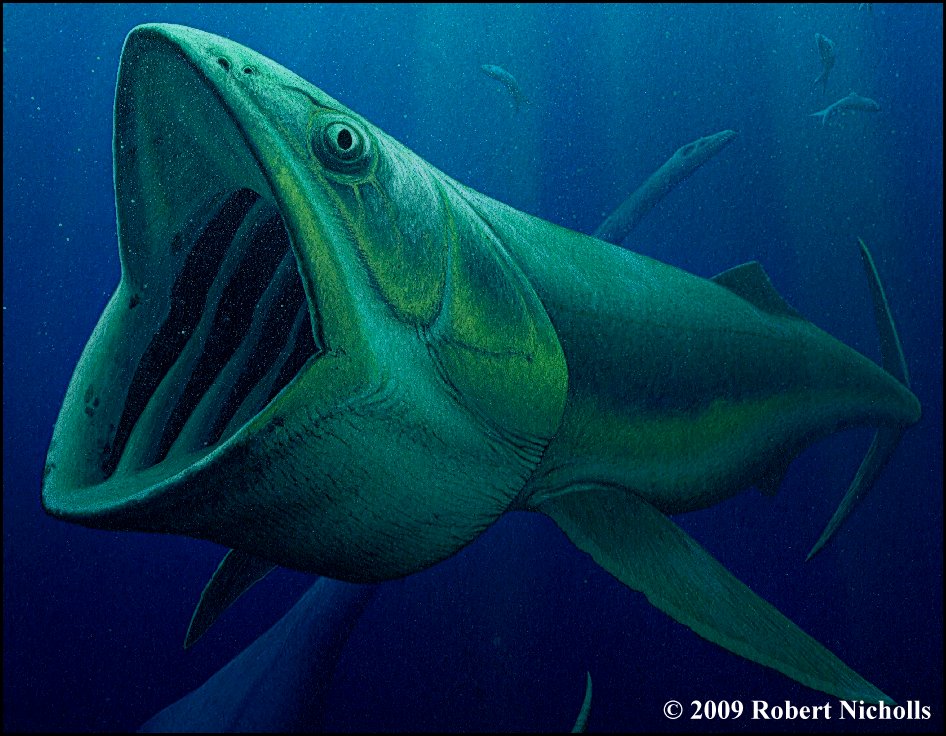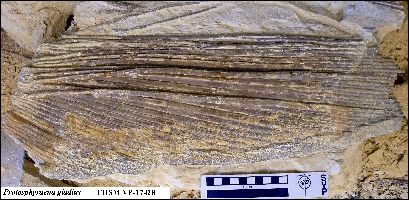|
|
Post by Infinity Blade on Mar 8, 2015 5:17:59 GMT 5
Bonnerichthys gladiusTemporal range: Late Cretaceous (89-83Ma) Scientific classification: Kingdom: AnimaliaPhylum: ChordataClass: ActinopterygiiOrder: † PachycormiformesFamily: † PachycormidaeGenus: † BonnerichthysSpecies: † B. gladius Bonnerichthys gladius Bonnerichthys gladius is an extinct species of actinopterygian that lived in the Western Interior Seaway (it was found in the Niobrara Formation in Kansas) during the Late Cretaceous. It was a filter feeder that subsisted on plankton. The pectoral fins each had a sharp edge that could be used as defensive weapons against predators. The tail was crescent-shaped and the upper and lower lobes were equal in length, ergo, it would have been a powerful swimmer. [1]References:[1] White, S. (Ed.). (2012). Dinosaur Art: The World's Greatest Paleoart. Titan Books.
|
|
|
|
Post by Infinity Blade on Jan 4, 2020 4:50:24 GMT 5
Just to prove I wasn't lying about the whole pectoral fin cutting edge part:  The above photograph is from the same source listed in the OP. Here's further material from the Ocean of Kansas website-> with italicized captions:  LEFT: Although a fair number (about 20) of specimens of the fins of this species have been collected from as far back as the 1870s (Stewart (1988), up until now, I had only collected a small piece of one... the fin fragment shown above left, discovered a little ways north of Castle Rock in Gove County. In cross-section and front view, this fragment illustrates the sharp leading edge of these fins. LEFT: Although a fair number (about 20) of specimens of the fins of this species have been collected from as far back as the 1870s (Stewart (1988), up until now, I had only collected a small piece of one... the fin fragment shown above left, discovered a little ways north of Castle Rock in Gove County. In cross-section and front view, this fragment illustrates the sharp leading edge of these fins.Note: ' Protosphyraena' gladius was the former name of Bonnerichthys gladius.  LEFT: Here's the fin as prepared (Photo by K. Shimada) - Note the heavy and relatively sharp leading edge (lower side of photo): LEFT: Here's the fin as prepared (Photo by K. Shimada) - Note the heavy and relatively sharp leading edge (lower side of photo): |
|
|
|
Post by kekistani on Jan 4, 2020 12:29:59 GMT 5
Just to prove I wasn't lying about the whole pectoral fin cutting edge part:  The above photograph is from the same source listed in the OP. Here's further material from the Ocean of Kansas website-> with italicized captions:  LEFT: Although a fair number (about 20) of specimens of the fins of this species have been collected from as far back as the 1870s (Stewart (1988), up until now, I had only collected a small piece of one... the fin fragment shown above left, discovered a little ways north of Castle Rock in Gove County. In cross-section and front view, this fragment illustrates the sharp leading edge of these fins. LEFT: Although a fair number (about 20) of specimens of the fins of this species have been collected from as far back as the 1870s (Stewart (1988), up until now, I had only collected a small piece of one... the fin fragment shown above left, discovered a little ways north of Castle Rock in Gove County. In cross-section and front view, this fragment illustrates the sharp leading edge of these fins.Note: ' Protosphyraena' gladius was the former name of Bonnerichthys gladius.  LEFT: Here's the fin as prepared (Photo by K. Shimada) - Note the heavy and relatively sharp leading edge (lower side of photo): LEFT: Here's the fin as prepared (Photo by K. Shimada) - Note the heavy and relatively sharp leading edge (lower side of photo):What book is this? |
|
|
|
Post by Infinity Blade on Jan 4, 2020 18:35:55 GMT 5
I said the first pic was from the same source I cited in the OP. The other two are from the Ocean of Kansas website, which I also linked to.
|
|
|
|
Post by Infinity Blade on Feb 4, 2022 21:31:01 GMT 5
|
|